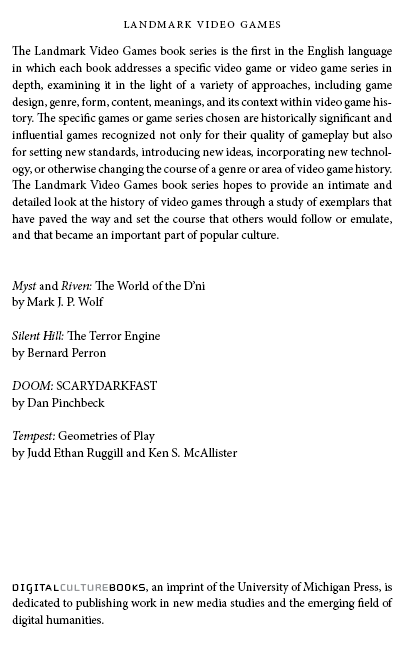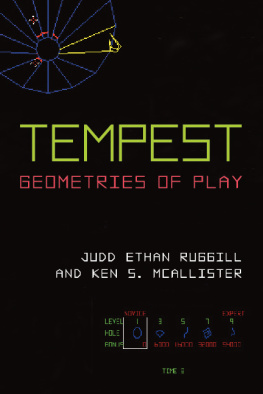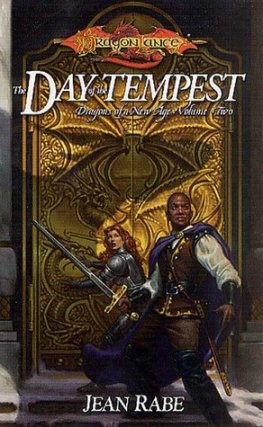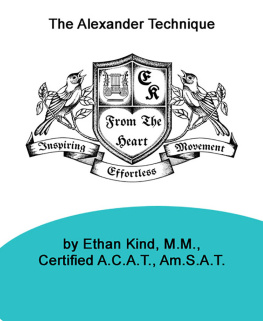Judd Ethan Ruggill - Tempest: Geometries of Play
Here you can read online Judd Ethan Ruggill - Tempest: Geometries of Play full text of the book (entire story) in english for free. Download pdf and epub, get meaning, cover and reviews about this ebook. year: 2018, publisher: The University of Michigan Press, genre: Romance novel. Description of the work, (preface) as well as reviews are available. Best literature library LitArk.com created for fans of good reading and offers a wide selection of genres:
Romance novel
Science fiction
Adventure
Detective
Science
History
Home and family
Prose
Art
Politics
Computer
Non-fiction
Religion
Business
Children
Humor
Choose a favorite category and find really read worthwhile books. Enjoy immersion in the world of imagination, feel the emotions of the characters or learn something new for yourself, make an fascinating discovery.
- Book:Tempest: Geometries of Play
- Author:
- Publisher:The University of Michigan Press
- Genre:
- Year:2018
- Rating:4 / 5
- Favourites:Add to favourites
- Your mark:
- 80
- 1
- 2
- 3
- 4
- 5
Tempest: Geometries of Play: summary, description and annotation
We offer to read an annotation, description, summary or preface (depends on what the author of the book "Tempest: Geometries of Play" wrote himself). If you haven't found the necessary information about the book — write in the comments, we will try to find it.
Tempest: Geometries of Play — read online for free the complete book (whole text) full work
Below is the text of the book, divided by pages. System saving the place of the last page read, allows you to conveniently read the book "Tempest: Geometries of Play" online for free, without having to search again every time where you left off. Put a bookmark, and you can go to the page where you finished reading at any time.
Font size:
Interval:
Bookmark:
 Page i
Page i  Page ii Page iii
Page ii Page iii Judd Ethan Ruggill
and
Ken S. McAllister
University of Michigan Press
Ann Arbor
Page ivCopyright by Judd Ethan Ruggill and Ken S. McAllister 2015
Some rights reserved

This work is licensed under the Creative Commons Attribution-Noncommercial-No Derivative Works 3.0 United States License. To view a copy of this license, visit http://creativecommons.org/licenses/by-nc-nd/3.0/ or send a letter to Creative Commons, 171 Second Street, Suite 300, San Francisco, California, 94105, USA.
Published in the United States of America by the
University of Michigan Press
Manufactured in the United States of America
2018 2017 2016 2015 4 3 2 1
A CIP catalog record for this book is available from the British Library.
DOI: http://dx.doi.org/10.3998/lvg.13030180.0001.001
ISBN 9780-472072699 (hardcover : acid-free paper)
ISBN 9780-472052691 (paperback : acid-free paper)
ISBN 9780-472121144 (e-book)
Page v JER: To my buddy, Skyrest in peaches... or at least in melon. And to my buddy, Simon, the Sneaky Pete: I do so miss the kangaroo foot.
KSM: For Yrgl, B.O.C.: The worlds greatest tripod.
Page vi Page viiIt is with deep gratitude and sincere pleasure that we recognize the following folks for their interest (genuine or feigned) in, encouragement of, and contribution to the researching and writing of this book:
Tom Dwyer, Christopher Dreyer, Aaron McCollough, Andrea Olson, Mary Hashman, and the staff and editorial board of the University of Michigan Press. Your professionalism, excellence, and flexibility were a joy.
Mark Wolf and Bernard Perron. Your vision and courage to launch the Landmark Video Games series has been inspiring and will undoubtedly prove a landmark in the history of game studies when all is said and done.
The anonymous reviewers who vetted our manuscript. The book is infinitely better for your suggestions.
All the kind people who generously granted us permission to use their materials, especially Greg McLemore, Rich Wiebke, Matt Reichert, and Casandra Brown.
The faculty, staff, and students of Arizona State University and the University of Arizona, in particular Carole Beal, Patti Bellew, Michael Bluhm, Mike Bruck, Ellen Burgess, Bryan Carter, Alan Chu, Paul Cohen, Jos Cortez, Ryan Cresawn, Theresa Darras, Theresa Devine, Javier Durn, Lyn Duran, Alison Dushane, Yvonne Ervin, Richard Edmiston, Jeremy Frumkin, Cynthia Gaffney, Derek Green, Diane Gruber, Crystal Gustavson, Alex Halavais, Al Harahap, Paul Hurh, Kim Jones, Jeff Kassing, Doug Kelley, Hazel Page viii Kwon, Jan Lacey, Marvin Landis, Justin LeBreck, Jerry Lee, Chris Lukinbeal, Lindsey Men, Sharonne Meyerson, Clay Morrison, Carol Mueller, Majia Nadesan, Ramsey Eric Ramsey, Jon Reinhardt, Bart Rossman, Krysti Roush, Joellen Russell, Kris Sansbury, Gloria Sawrey, Charles Watkins Scruggs III, Jessica Shumake, Kayo Shintaku, Debbie Spargur, Jason Striker, Jane Strohm, Kelland Thomas, Marlene Tromp, Elise Verzosa, Vince Waldron, John Warnock, Bonnie Wentzel, Suzanne Westbrook, Mary Wildner-Bassett, Greg Wise, and Cassie Wright. Thank you for contributing to an outstanding and supportive work environment.
Our national and international colleagues, principally Steven Conway, Jennifer deWinter, Harrison Gish, Daniel Griffin, Carly Kocurek, Kevin Moberly, Ryan Moeller, Randy Nichols, Rolf Nohr, David OGrady, Marc Ouellette, Matthew Payne, and Jason Thompson. Thanks kindly for helping us think through Tempests innovations and implications.
Our family and friends: Gwen Downey, Marvelous Marvin Duckler, Gina Hernandez, Justine Hernandez, Paula Klein, Jamie Lee, Adela and Dorothy Licona, Mandy McAllister, Amiee and Tara McDougal, Jacob Paige, Susan Reggin (for all the quarters), the Richter family, Bob Ruggill, Jane Ruggill, Dan Shindell, Rachel Srubas and all her kith and kin, and Aida and Sophia Villarreal. Your ability to tolerate us and our strange pursuits was the chief catalyst for this book.
Page ixFig. 1. Different arcade machine form factors
Fig. 2. Play screen
Fig. 3. Shooter
Fig. 4. Flipper
Fig. 5. Tanker
Fig. 6. Spiker
Fig. 7. Fuseball
Fig. 8. Pulsar
Fig. 9. Skill-Step
Fig. 10. Assortment of technical documents
Fig. 11. Operator-Information Display
Fig. 12. Self-Test
Fig. 13. Spinner
Fig. 14. Tempest cabinet/side art aliens
Fig. 15. 1980s arcade images
Fig. 16. 1980s arcade images
Fig. 17. 1980s arcade images
Fig. 18. Bally/Midway auxiliary show monitor
Fig. 19. Atari Tempest for 2600 prototype cart
Fig. 20. Atari Tempest for 2600 prototype box art
Fig. 21. Atari Tempest arts and crafts
Page xii Page 1The year 1980 was a landmark one for video games. As Scott Cohen notes in his now classic history of Atari, the companys [r]evenues for 1980 doubled to about $415 million, and operating income quintupled to $77 million, one-third of [parent company and media giant] Warners total 1980 operating income. In six months Warner stock shot up 35 percent. Atari was the fastest growing company in the history of America (1984, 73). While Atari was certainly the largest industry player at the time and expanding at an unparalleled rate, it did not hold a monopoly on the video game medium. In fact, comparatively, the game industry in 1980 was remarkably open to new entrants and innovations. Activision, for example, sold $65.9 million in software [that same year], for a profit of $12.9 million (Cohen 1984, 83), and there were many extant and emerging competitors to Ataris Video Computer System (VCS), including the Odyssey2 (Magnavox), Intellivison (Mattel), and Channel F (Fairchild). At the same time, coin-operated, console, and handheld play were all lively and synergistic. Not only were the arcade and home markets both bustling, but console developers were also actively and successfully drawing from arcade source material (e.g., Ataris VCS adaptation of Taito/Midways Space Invaders). In addition, 1980 was a particularly fertile time for game design. Developers released a superabundance of titles that rank among the most iconic and influential of all time: Battlezone, Berzerk, Crazy Climber, Defender, Missile Command, Pac-Man, Zork: The Great Underground Empire, and others. Indeed, while video game history is full of important moments, 1980 may well be the year the medium came of age as a commercial, artistic, and cultural force.
That Tempest should have emerged in the wake of this especial lan Page 2 is only fitting. It is a landmark game in every sense of the term, from its abstract and futuristic imagery and gameplay to its impact on more than three decades of subsequent game design and development. It is a game that today, more than thirty years after its release, even non-players recognize as somehow unique and important.
And yet, Tempest largely remains as enigmatic an artifact as when it was first released. Little has been done to unpack its significance or trace its form and functioning. Part of the reticence to undertake this work can be traced to the state of the field: like its object of focus, video game studies is still nascent and mercurial. It has not yet been wholly annealed by time or tradition, and as a result, much path-breaking is still to be done. By the same token,
Font size:
Interval:
Bookmark:
Similar books «Tempest: Geometries of Play»
Look at similar books to Tempest: Geometries of Play. We have selected literature similar in name and meaning in the hope of providing readers with more options to find new, interesting, not yet read works.
Discussion, reviews of the book Tempest: Geometries of Play and just readers' own opinions. Leave your comments, write what you think about the work, its meaning or the main characters. Specify what exactly you liked and what you didn't like, and why you think so.












